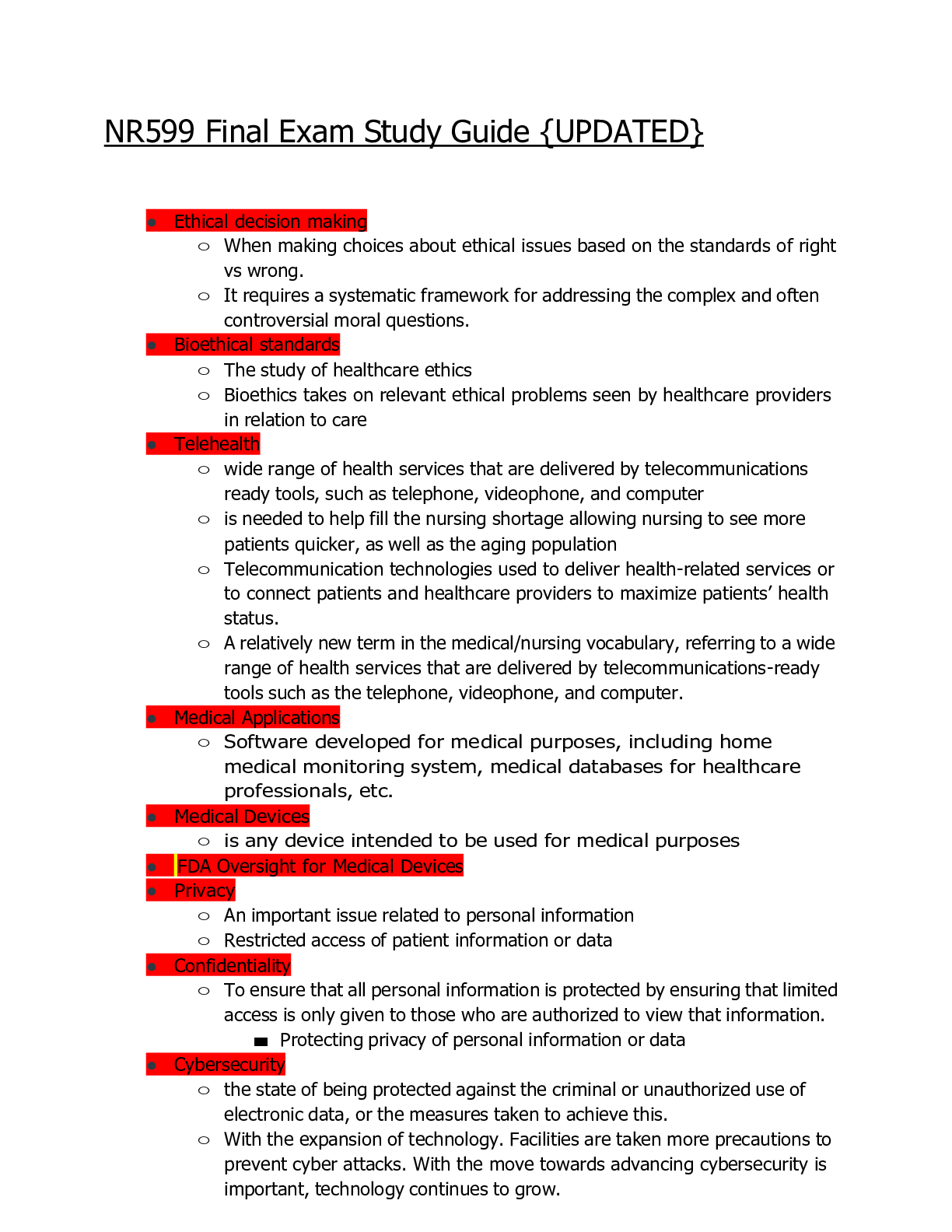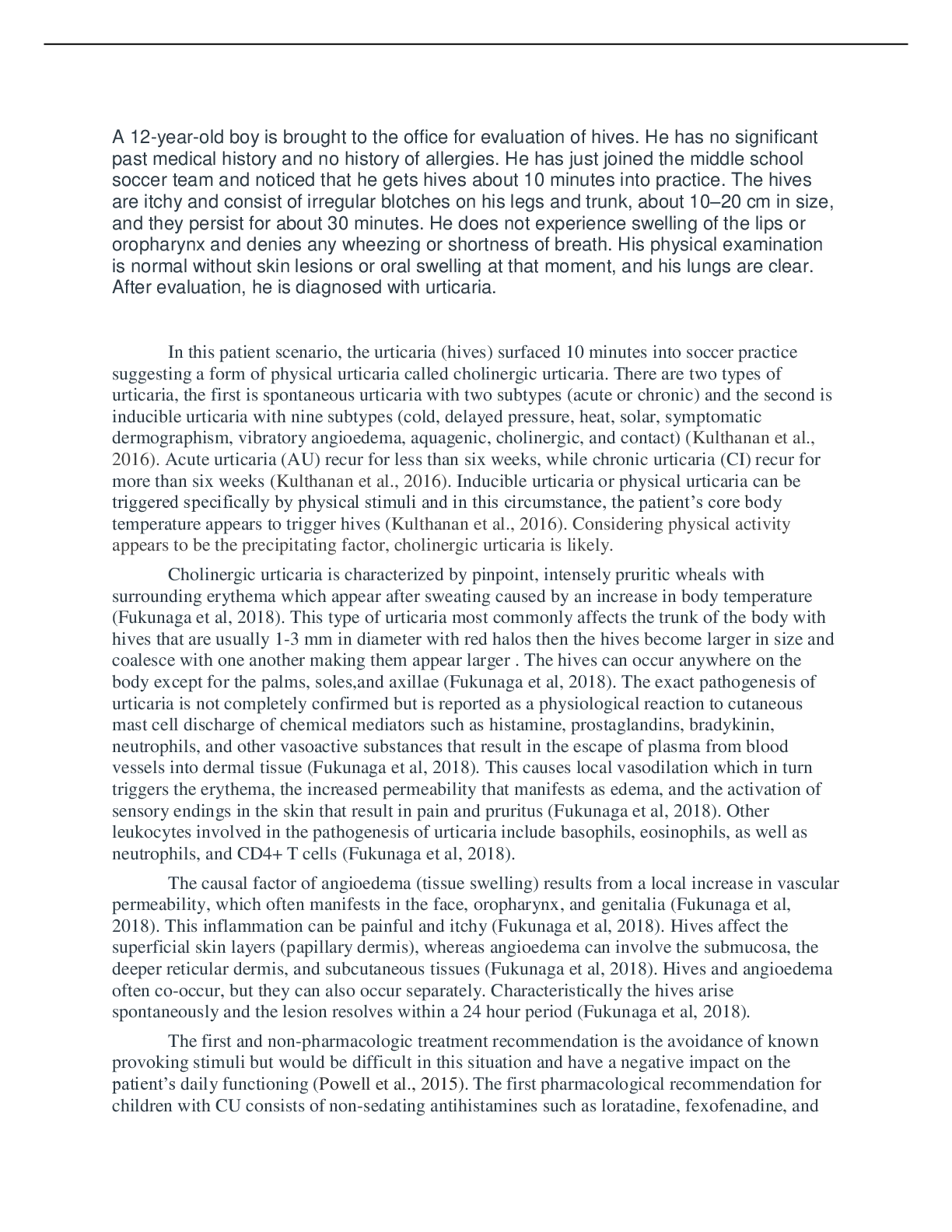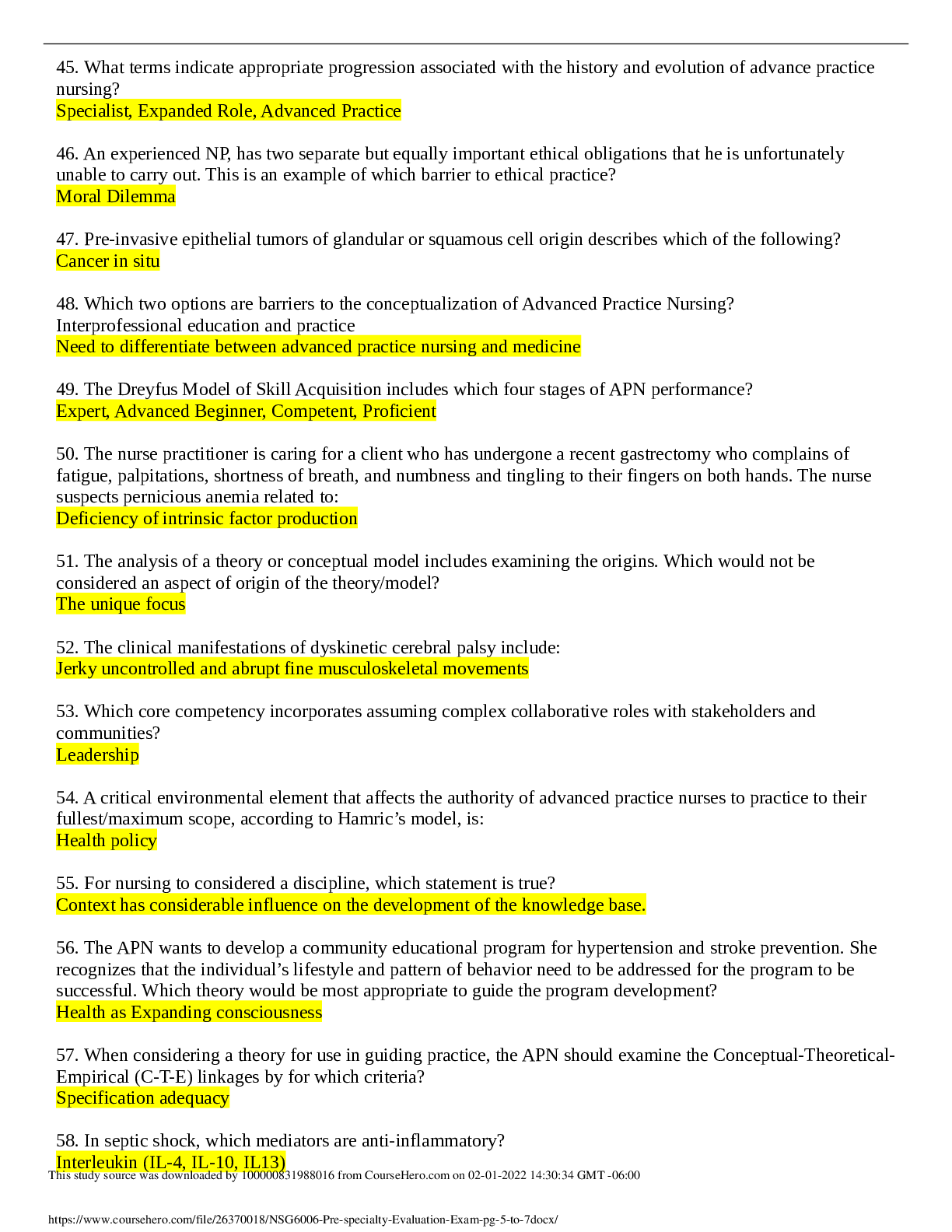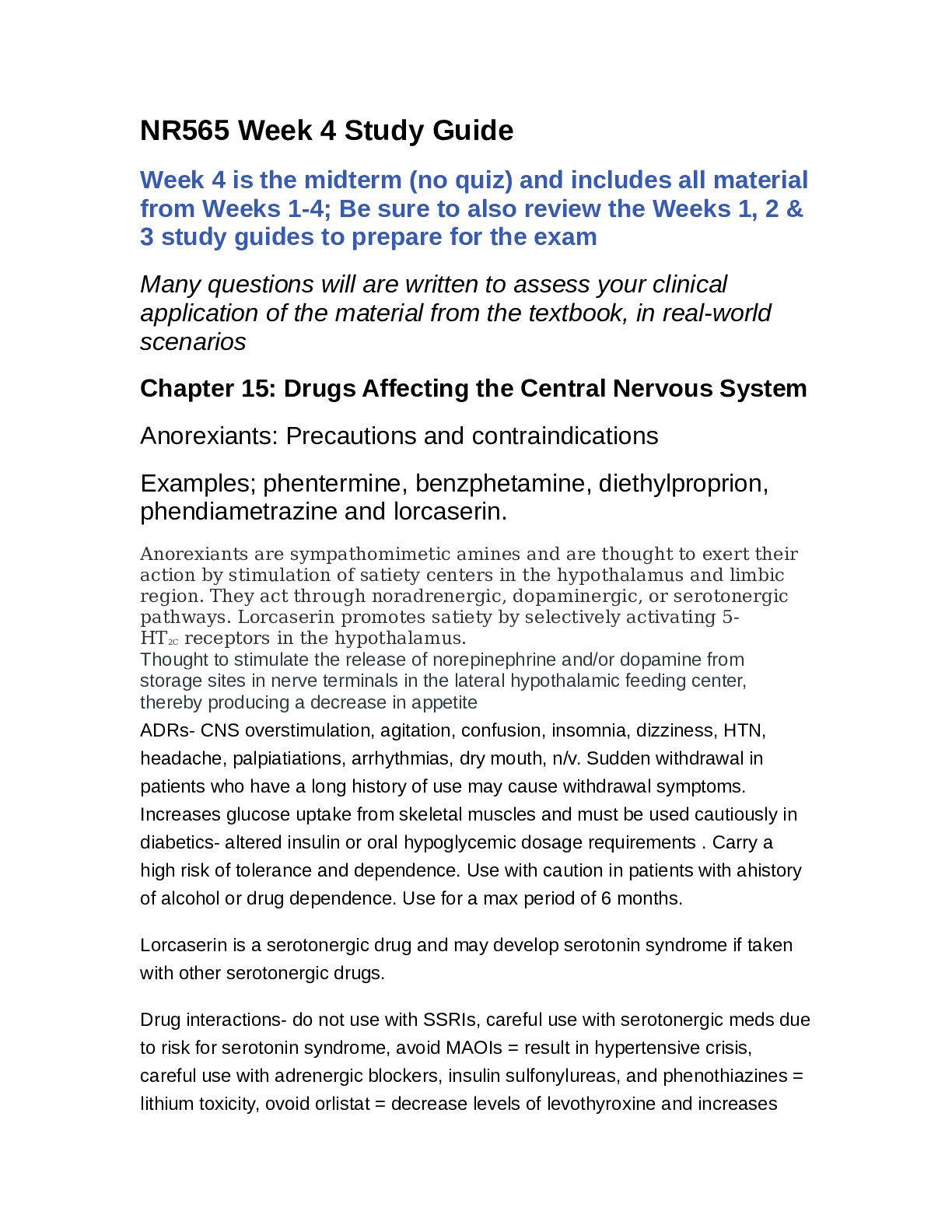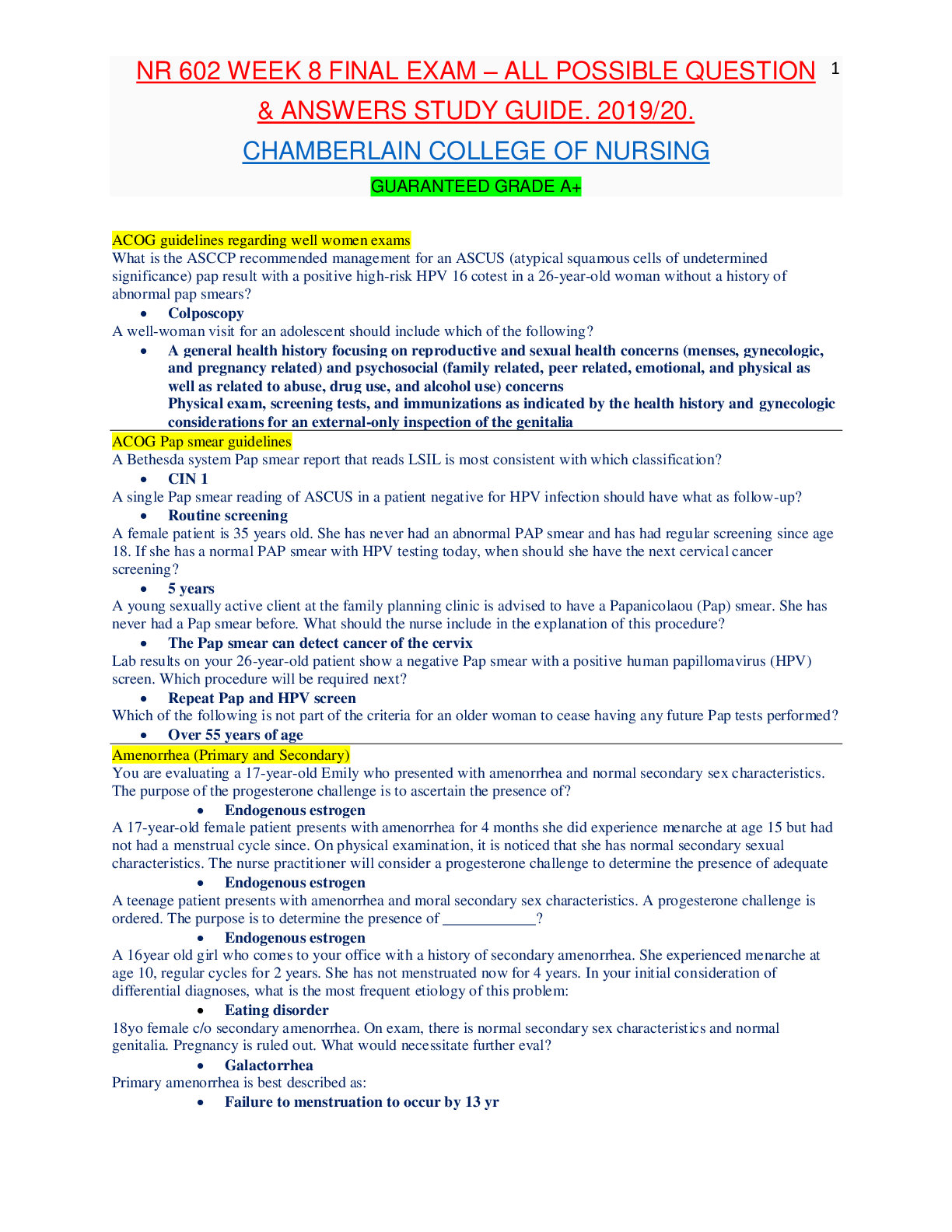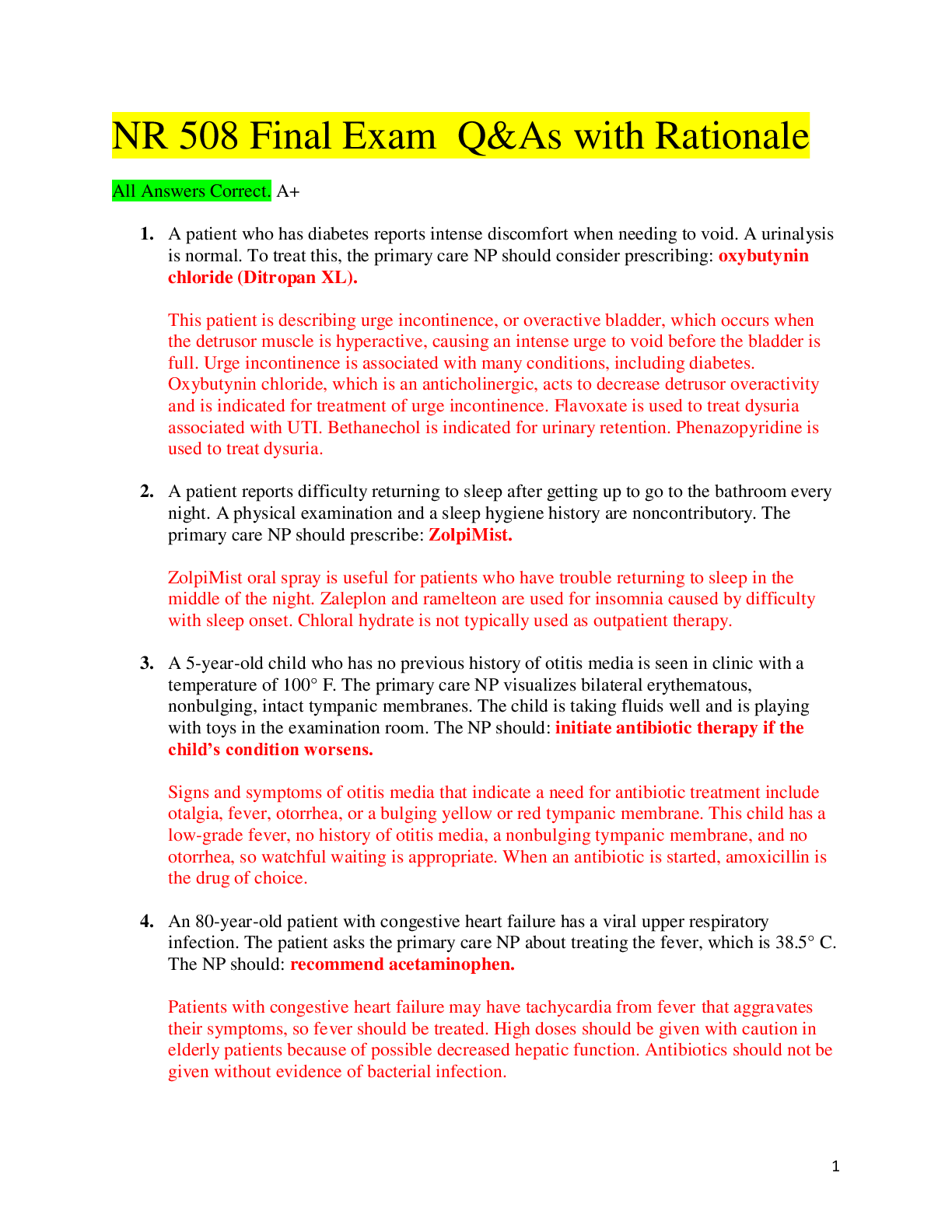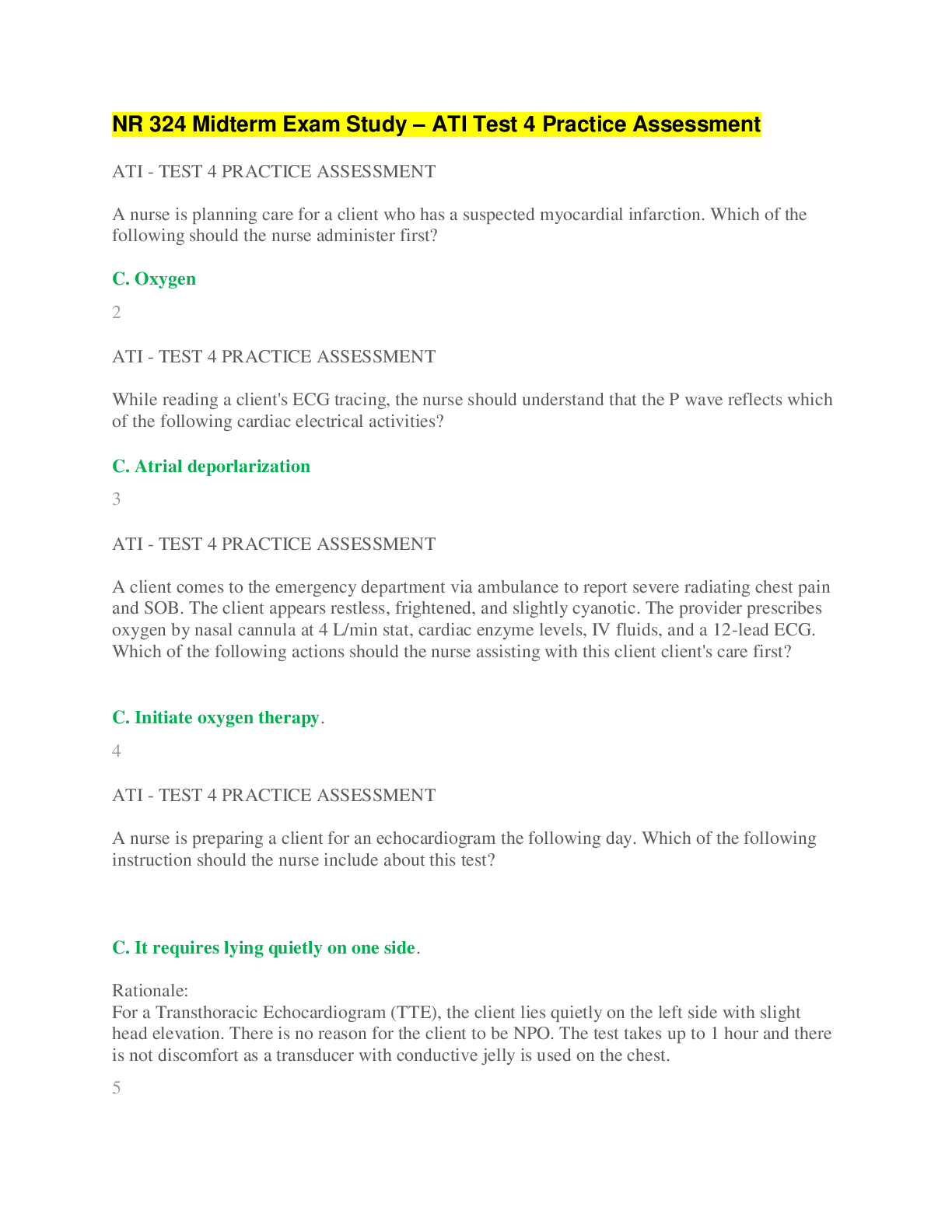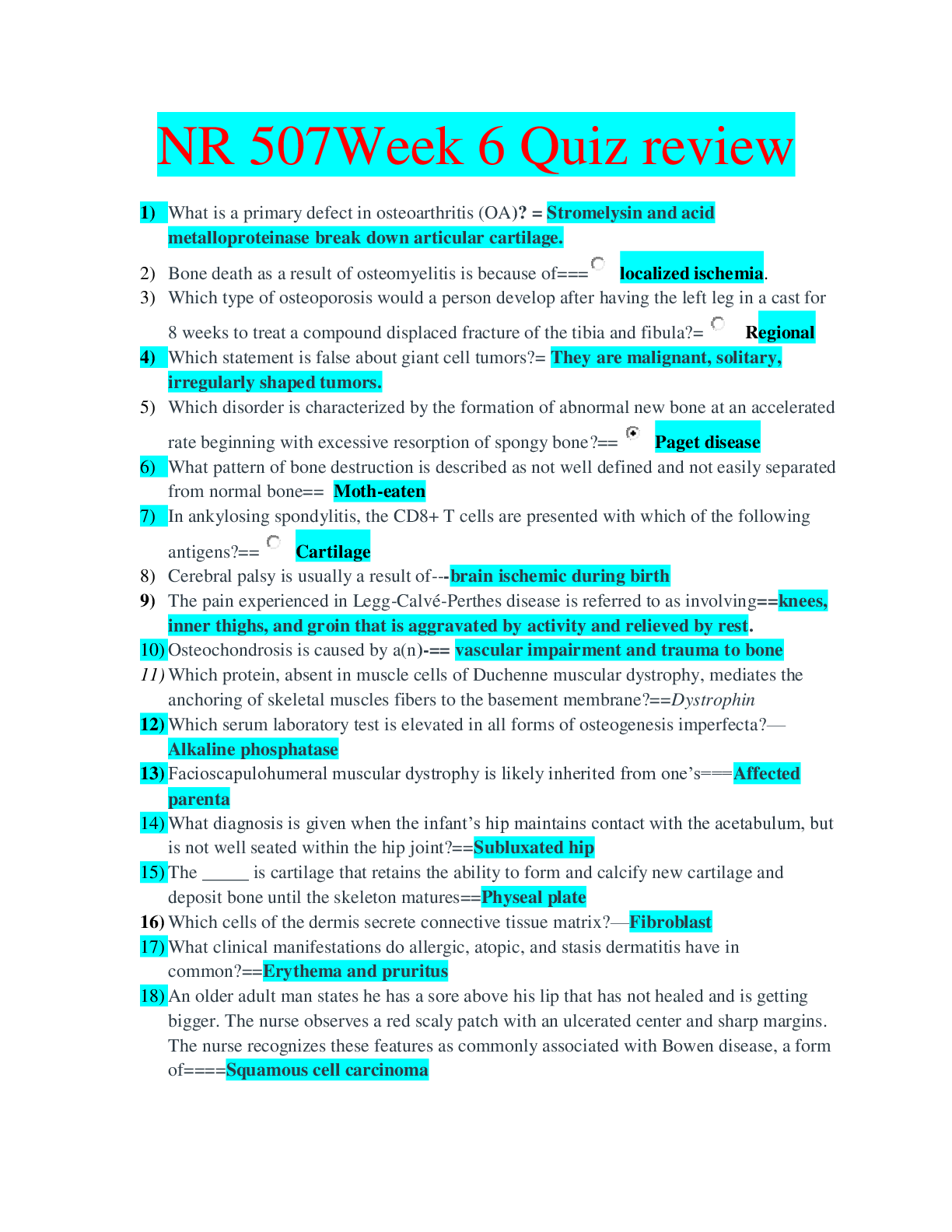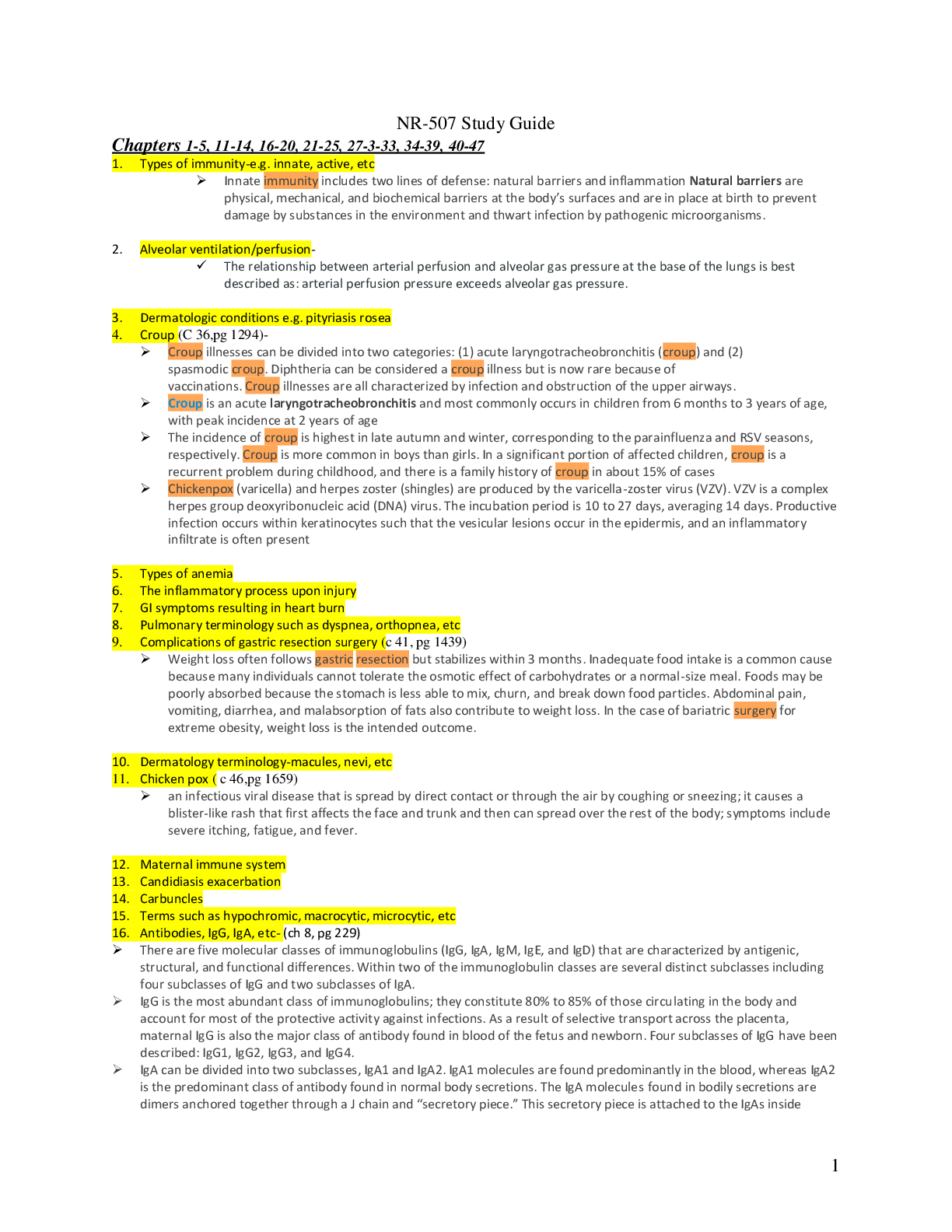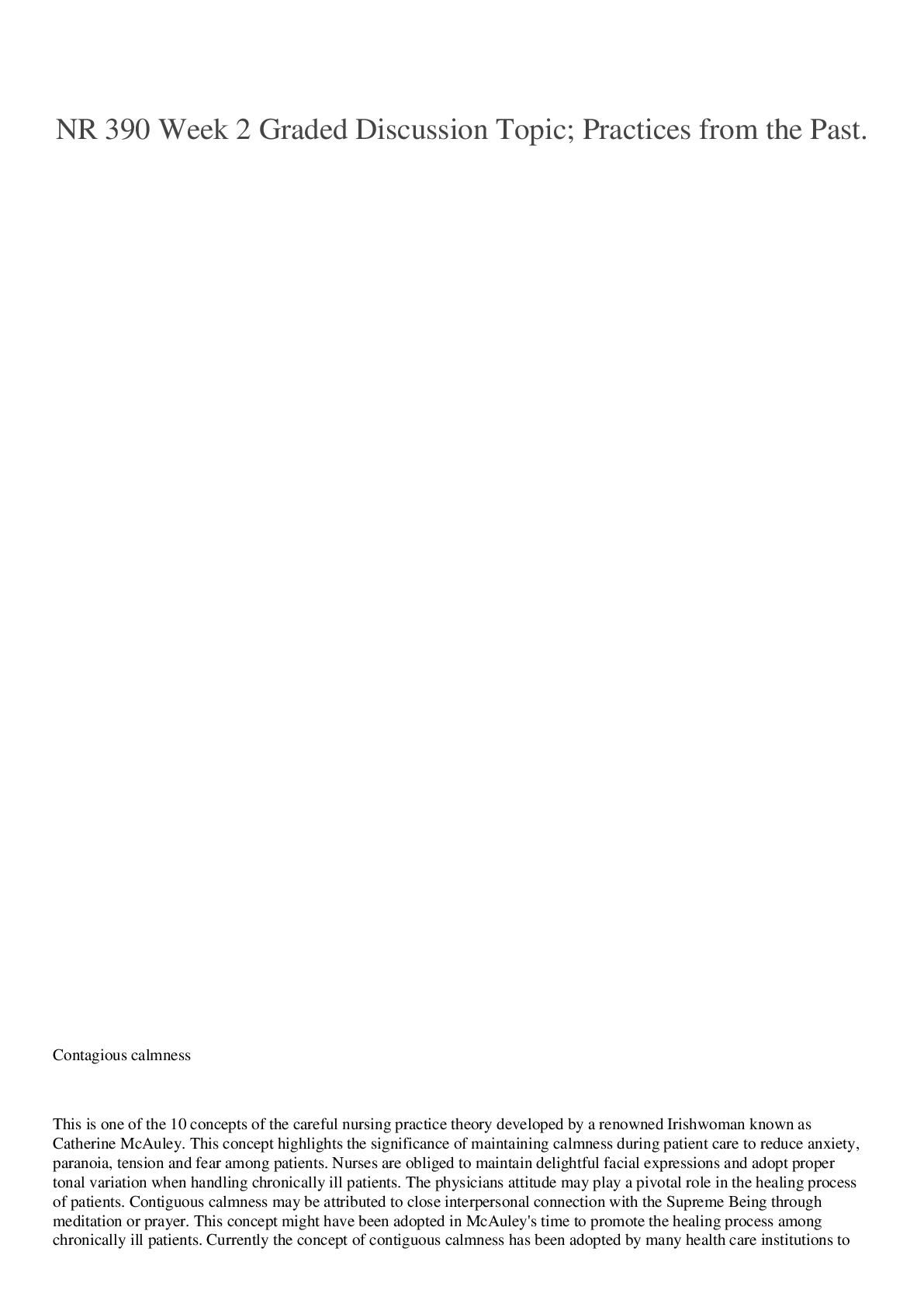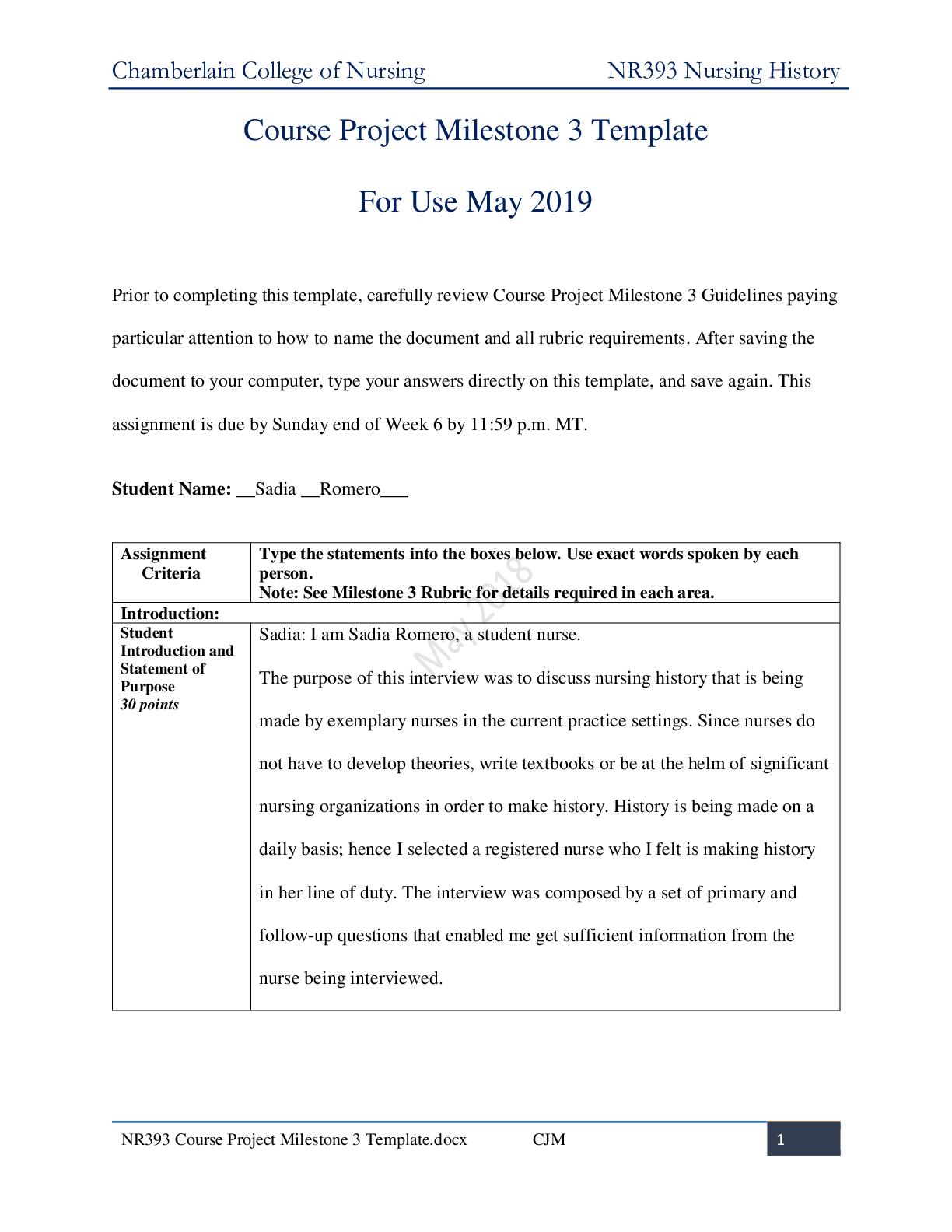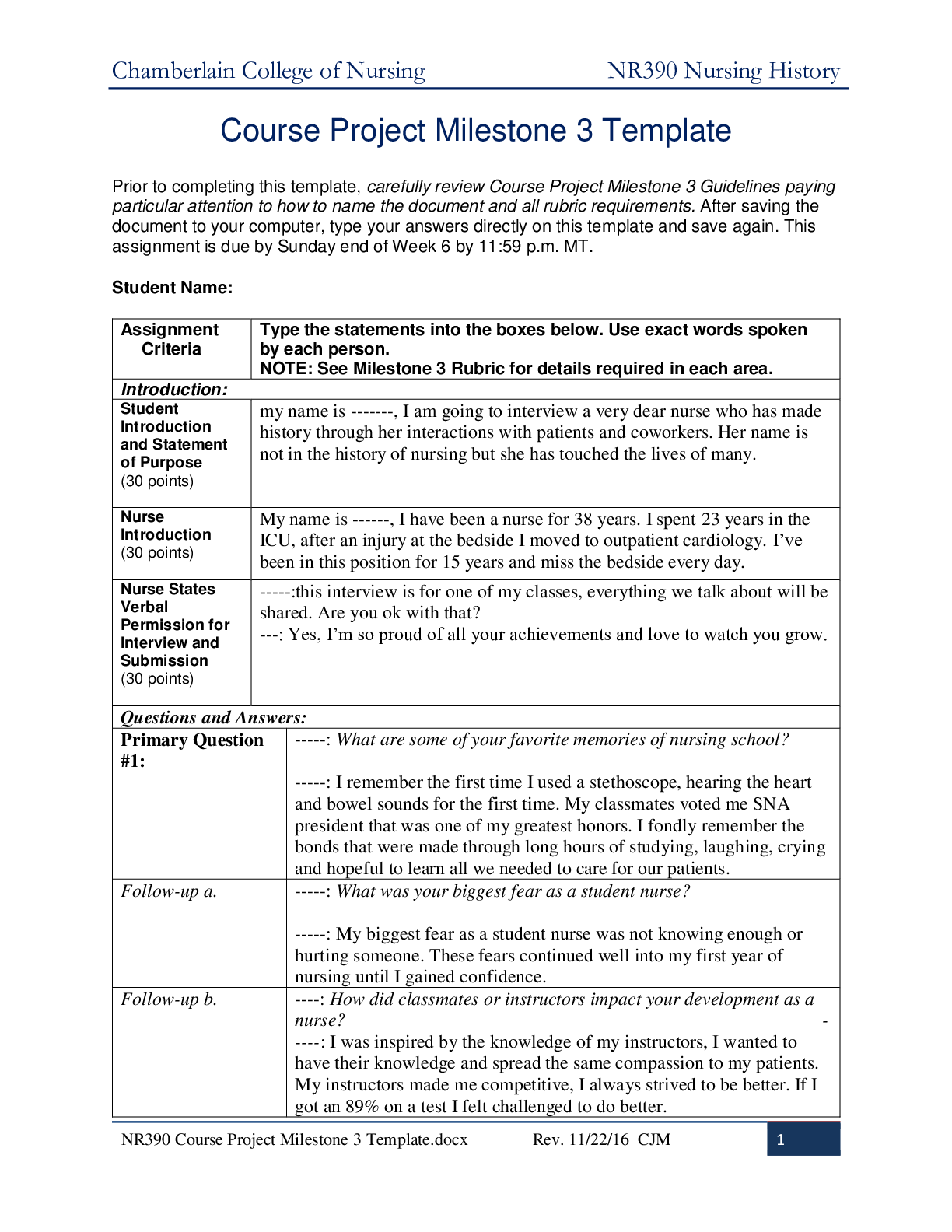*NURSING > STUDY GUIDE > NR 599 Informatics Midterm Study Guide – Chamberlain College of Nursing | NR599 Informatics Midter (All)
NR 599 Informatics Midterm Study Guide – Chamberlain College of Nursing | NR599 Informatics Midterm Study Guide
Document Content and Description Below
Midterm study guide 1. Principles of nursing informatics Nursing Science a building block of NI NI is a specialty that integrates nursing science, computer science, cognitive science and i... nformation science to manage and communicate data, information, knowledge, and wisdom in nursing practice. ursing informatics (NI) is the specialty that integrates nursing science with multiple information and analytical sciences to identify, define, manage, and communicate data, information, knowledge and wisdom in nursing practice. 2. Knowledge is the awareness and understanding of a set of information and ways that information can be made useful to support a specific task or arrive at a decision Knowledge abounds with others’ thoughts and information Knowledge model-conceptual organized framework for NI, tied to nursing science and the practice of nursing informatics Nursing knowledge is created, stored, acquired, used, generated, engineered, disseminate Epistemology is the study of the nature and origin of knowledge—that is, what it means to know. Three sources of knowledge have been identified: (1) instinct, (2) reason, and (3) intuition. 3. Wisdom is the application of knowledge to an appropriate situation. Guides actions developed through knowledge, experience, insight, and reflection highest form of common sense it is the ability to apply valuable and viable knowledge, experience, understanding, and insight while being prudent and sensible. focused on one’s own mind The appropriate use of knowledge to solve human problems the foundation of the art of nursing. 4. Scientific underpinning conceptual framework underpinning the science and practice of NI centers on the core concepts of data, information, knowledge, and wisdom, also known as the DIKW paradigm 5. Foundation of knowledge model suggests that the most important aspect of information discovery, retrieval, and delivery is the ability to acquire, process, generate, and disseminate knowledge in ways that help those managing the knowledge reevaluate and rethink the way they understand and use what they know and have learned. This study source was downloaded by 100000831988016 from CourseHero.com on 04-14-2022 01:07:25 GMT -05:00 https://www.coursehero.com/file/52260410/Informatics-Midterm-study-guide-docx/ 6. Information science a field of scientific inquiry and professional practice. primarily concerned with the input, processing, output, and feedback of data and information through technology integration with a focus on comprehending the perspective of the stakeholders involved and then applying IT as needed. processed data that has meaning. information is data made functional through the application of knowledge. Information is composed of data that were processed using knowledge. Data must be clean, of good quality to be meaningful and useful 7. Standard terminology International Council of Nurses’ International Classification of Nursing Practice (ICNP) initiative to standardize the language of nursing practice a nursing terminology that is in some way approved by an appropriate authority (de jure standardization) or by general consent (de facto standardization). Once standardized, a term can be measured and coded. Measurement of the nursing care through a standardized vocabulary by way of an ED [electronic documentation] will lead to the development of large databases. 8. Informatics competencies nurses should have the following critical skills: use e-mail, operate Windows applications, search databases, and know how to work with the institution-specific nursing software used for charting and medication administration. NI competency categories: (1) computer skills, (2) informatics knowledge, and (3) informatics skills NI competency skill levels: beginning nurse (basic knowledge), (2) experienced nurse (proficient), (3) informatics nurse specialist (advance), and (4) informatics innovator (generate research and theory). Level 1 and Level 2 competencies assessment: TANIC tool Level 3 and 4 competencies assessment: NICA L3/L4 tool 9. Information literacy an intellectual framework for finding, understanding, evaluating, and using information Determine the extent of information needed Access the needed information effectively and efficiently Evaluate information and its sources critically Incorporate selected information into one’s knowledge base Use information effectively to accomplish a specific purpose Understand the economic, legal, and social issues surrounding the use of information and access and use information ethically and legally 10. Health literacy This study source was downloaded by 100000831988016 from CourseHero.com on 04-14-2022 01:07:25 GMT -05:00 https://www.coursehero.com/file/52260410/Informatics-Midterm-study-guide-docx/ The degree to which individuals have the capacity to obtain, process, and understand basic health information and services needed to make appropriate health decisions’ ability to locate and evaluate health information for credibility and quality, to analyze the various risks and benefits of treatments, and to calculate dosages and interpret test results are among the tasks Almader-Douglas identified as essential for health literacy ability to negotiate complex healthcare environments and understand the economics of payment for services third of all Americans have health literacy problems 11. Computer science facilitate the acquisition and manipulation of data and information by nurses computers first developed in 1940s Users are also able to contribute to the development of knowledge through the use of productivity, creativity, and communication software. Health care networks: client-focused (telenursing, e-health), client supported, work-related, virtual and social networks 12. Cognitive science studies the mind, intelligence, and behavior from an information-processing perspective. H. Christopher Longuet-Higgins originated the term “cognitive science” in his 1973 Cognitive informatics an emerging transdisciplinary field of study that bridges the gap in understanding regarding how information is processed in the mind and in the computer 13. Human technology interface anytime a human uses technology, some type of hardware or software enables and supports the interaction Can be computer, smart phone, printer Can be in images, text or sound Can mimic human face to face such as video conferencing, telehealth 14. Health Information Technology Key element in achieving 3 objectives: better care, affordable care, and healthy populations and communities 15. Digital natives digital natives (patients who have grown up with technology) need to be taught differently than digital immigrants (those who are late adopters of technology typically born after 1982 and may also be referred to as “Generation Y.” This study source was downloaded by 100000831988016 from CourseHero.com on 04-14-2022 01:07:25 GMT -05:00 https://www.coursehero.com/file/52260410/Informatics-Midterm-study-guide-docx/ refers to learn using technology and learns quite well if information is presented in a format to which they are accustomed, such as an interactive video game to introduce them to a topic. comfortable using information that they can access via their handheld devices, such as smartphones and tablets, as well as wearable devices such as smartwatches 16. Alarm fatigue low response times to legitimate alarms and multiple false alarms (promoting alarm fatigue) created by alarm parameters that were too sensitive. 17. Electronic medical records systematic documentation of a client’s health status and health care in a secured digital format, meaning that they can be processed, stored, transmitted, and accessed by authorized interdisciplinary professionals for the purpose of supporting efficient, high-quality health care across the client’s healthcare continuum provide immediate detection and reporting of notifiable conditions. incorporation of geographic information systems allows public health data to be mapped to specific locations that may indicate an immediate need for intervention 18. HITECH Act of 2011, part of the American Recovery and Reinvestment Act (ARRA) two sets of standards established as regulatory requirements by the Office of the National Coordinator for Health Information Technology (ONC, 2013a) to help providers meet the meaningful use (MU) of electronic health records (EHRs). which set the 2014 deadline for implementing EHRs and provided the impetus for HIE initiatives. 19. Meaningful use primary purpose of the MU standards is to ensure that the EHRs across the nation meet an adequate standard for performance and that this standard increases in complexity over time to meet the expanded needs of the nation The first standard defined the MU of EHRs, and the second specified how EHRs are to be developed and certified to meet the MU criteria The Centers for Medicare & Medicaid Services (CMS) coupled this infrastructure regulation with an EHR incentive program to encourage providers and hospitals to adopt and implement certified technology 96% of U.S. hospitals have a certified EHR, and as of 2015, more than 87% of providers have adopted an EHR in their practice Phase 1 was focused on the implementation of certified EHRs meeting basic requirements, such as electronic exchange of information through ePrescribing (electronic prescriptions) and the ability to capture and report quality metrics. [Show More]
Last updated: 1 year ago
Preview 1 out of 5 pages
Instant download

Buy this document to get the full access instantly
Instant Download Access after purchase
Add to cartInstant download
Reviews( 0 )
Document information
Connected school, study & course
About the document
Uploaded On
Apr 14, 2022
Number of pages
5
Written in
Additional information
This document has been written for:
Uploaded
Apr 14, 2022
Downloads
0
Views
78
